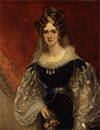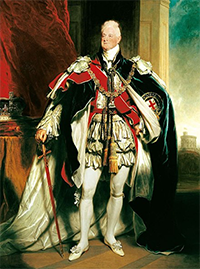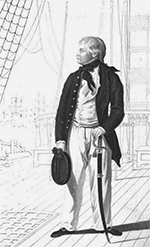King George IV of Great Britain and Ireland
He was born on Aug. 21, 1765, at St. Buckingham Palace. He was the third son of the current monarch, King George III, and Queen Charlotte of Mecklenburg-Strelitz. His oldest brother, George, was already Prince of Wales. His older brother, Frederick, was next in line to the throne. William was not expected to become king and so was sent off at 13 to join the Royal Navy. He saw action against the Spanish, at the 1780 Battle of St. Vincent, and against the Americans, in the Revolutionary War. He had command of his own ship, the HMS Pegasus, by 1786. He also served under Horatio Nelson, later to be a Napoleonic Wars hero. 
William returned home in 1791, having been named Duke of Clarence. He lived for 20 years with Irish actress Dorothea Bland, known as "Mrs. Jordan." The couple had 10 children, all of whom took the surname Fitzclarence. William had to get married, to someone else, because he had, in 1817, become heir to the throne. His father was still king, but Prince George had become Prince Regent in 1811 and the Prince Regent's daughter, Princess Charlotte, had died, leaving George without an heir. William and Adelaide of Saxe-Meiningen (right) were married in 1818. The couple had no children who survived infancy. 
Prince Regent became King George IV in 1820 and ruled for 10 years. William was 64 in 1830, when the king died, and became the oldest to assume the throne. Because of his naval background, he got the nickname "Sailor King." Much more frugal than his brother, he became popular with the people, beginning with his coronation, which cost a fraction of that of George IV. A blunt, no-nonsense man, he was fond of speaking his mind and at time forgot his tact. From an early age, he was called "Silly Billy." Parliament passed several very significant pieces of legislation during William's brief time on the throne:
William died of heart failure on June 20, 1837. He was 71. No children were in line to succeed him, so the throne passed to his niece Victoria, the daughter of William's younger brother, Edward, who had died in 1820. Also occurring during the reign of William IV:
|
|
Social Studies for Kids
copyright 2002–2025
David White



 William IV was the last of the Hanoverian kings of Great Britain. He reigned for seven eventful years in the early 19th Century.
William IV was the last of the Hanoverian kings of Great Britain. He reigned for seven eventful years in the early 19th Century.
